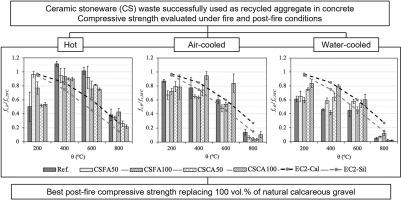当前位置:
X-MOL 学术
›
J. Build. Eng.
›
论文详情
Our official English website, www.x-mol.net, welcomes your feedback! (Note: you will need to create a separate account there.)
Fire and postfire compressive strength of recycled aggregate concrete made with ceramic stoneware
Journal of Building Engineering ( IF 6.4 ) Pub Date : 2024-04-17 , DOI: 10.1016/j.jobe.2024.109363 V. Albero , L. Reig , D. Hernández-Figueirido , M. Roig-Flores , A. Melchor-Eixea , A. Piquer , A.M. Pitarch
Journal of Building Engineering ( IF 6.4 ) Pub Date : 2024-04-17 , DOI: 10.1016/j.jobe.2024.109363 V. Albero , L. Reig , D. Hernández-Figueirido , M. Roig-Flores , A. Melchor-Eixea , A. Piquer , A.M. Pitarch

|
This study investigated the possibilities of reusing ceramic stoneware (CS) waste, a particular type of tiles ceramic waste (TCW), provided by a treatment plant in Castellon (east Spain), as recycled aggregate in structural concrete, and its influence on concrete behaviour when exposed to elevated temperatures (200 °C, 400 °C, 600 °C, 800 °C; compressive strength determined in hot and after air and water cooling). Although all samples exhibited similar strength values at room temperature, their thermal conductivity reduced with increasing CS contents. Strength values progressively dropped with rising temperatures, with the highest results recorded in hot, followed by air and, finally, by water cooling. Smaller differences between the strength registered in hot and after cooling were generally recorded in the recycled aggregate concretes (RAC) than in the reference sample. The concrete prepared with 100 vol% CS gravel was the only one to generally provide better residual strength after air-cooling than in hot.
中文翻译:

陶瓷陶瓷再生骨料混凝土的火灾和火灾后抗压强度
本研究调查了将卡斯特利翁(西班牙东部)一家处理厂提供的陶器(CS)废料(一种特殊类型的瓷砖陶瓷废料(TCW))重新用作结构混凝土中的再生骨料的可能性,及其对混凝土性能的影响当暴露于高温时(200°C、400°C、600°C、800°C;压缩强度在热和空气和水冷却后测定)。尽管所有样品在室温下表现出相似的强度值,但它们的导热率随着CS含量的增加而降低。强度值随着温度的升高而逐渐下降,在热时记录的结果最高,其次是空气冷却,最后是水冷。与参考样品相比,再生骨料混凝土 (RAC) 中记录的热强度和冷却后强度之间的差异通常较小。用 100 vol% CS 砾石配制的混凝土是唯一一种在空冷后通常比热态下提供更好残余强度的混凝土。
更新日期:2024-04-17
中文翻译:

陶瓷陶瓷再生骨料混凝土的火灾和火灾后抗压强度
本研究调查了将卡斯特利翁(西班牙东部)一家处理厂提供的陶器(CS)废料(一种特殊类型的瓷砖陶瓷废料(TCW))重新用作结构混凝土中的再生骨料的可能性,及其对混凝土性能的影响当暴露于高温时(200°C、400°C、600°C、800°C;压缩强度在热和空气和水冷却后测定)。尽管所有样品在室温下表现出相似的强度值,但它们的导热率随着CS含量的增加而降低。强度值随着温度的升高而逐渐下降,在热时记录的结果最高,其次是空气冷却,最后是水冷。与参考样品相比,再生骨料混凝土 (RAC) 中记录的热强度和冷却后强度之间的差异通常较小。用 100 vol% CS 砾石配制的混凝土是唯一一种在空冷后通常比热态下提供更好残余强度的混凝土。



























 京公网安备 11010802027423号
京公网安备 11010802027423号